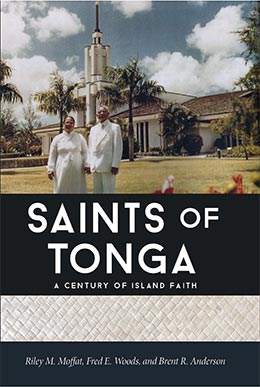Establishing a Tongan Church Led by Tongans (1970-79)
Riley M. Moffat, Fred E. Woods, and Brent R. Anderson, "Establishing a Tongan Church Led by Tongans (1970-79)," in Saints of Tonga (Religious Studies Center, Brigham Young University; Salt Lake City: Deseret Book, 2019), 313–340.
The Creation of More Stakes in Tonga
The first Tongan stake, the Nuku‘alofa Tonga Stake, was formed in 1968. The new stake leadership positions were filled primarily by local Tongan Saints, who had gained significant experience leading districts that had been administered as if they were stakes. The maturity of the Church on Tongatapu was best illustrated by the rapid growth of the Nuku‘alofa Tonga Stake, which was split into three stakes on July 26, 1970, just two years after its creation. Tevita Ka‘ili replaced Orson Hyde White as stake president of the original Nuku‘alofa Tonga Stake, and the two new stakes were the Nuku‘alofa Tonga South Stake, with Tevita Folau Mahu‘inga as president, and the Nuku‘alofa Tonga West Stake, led by White.
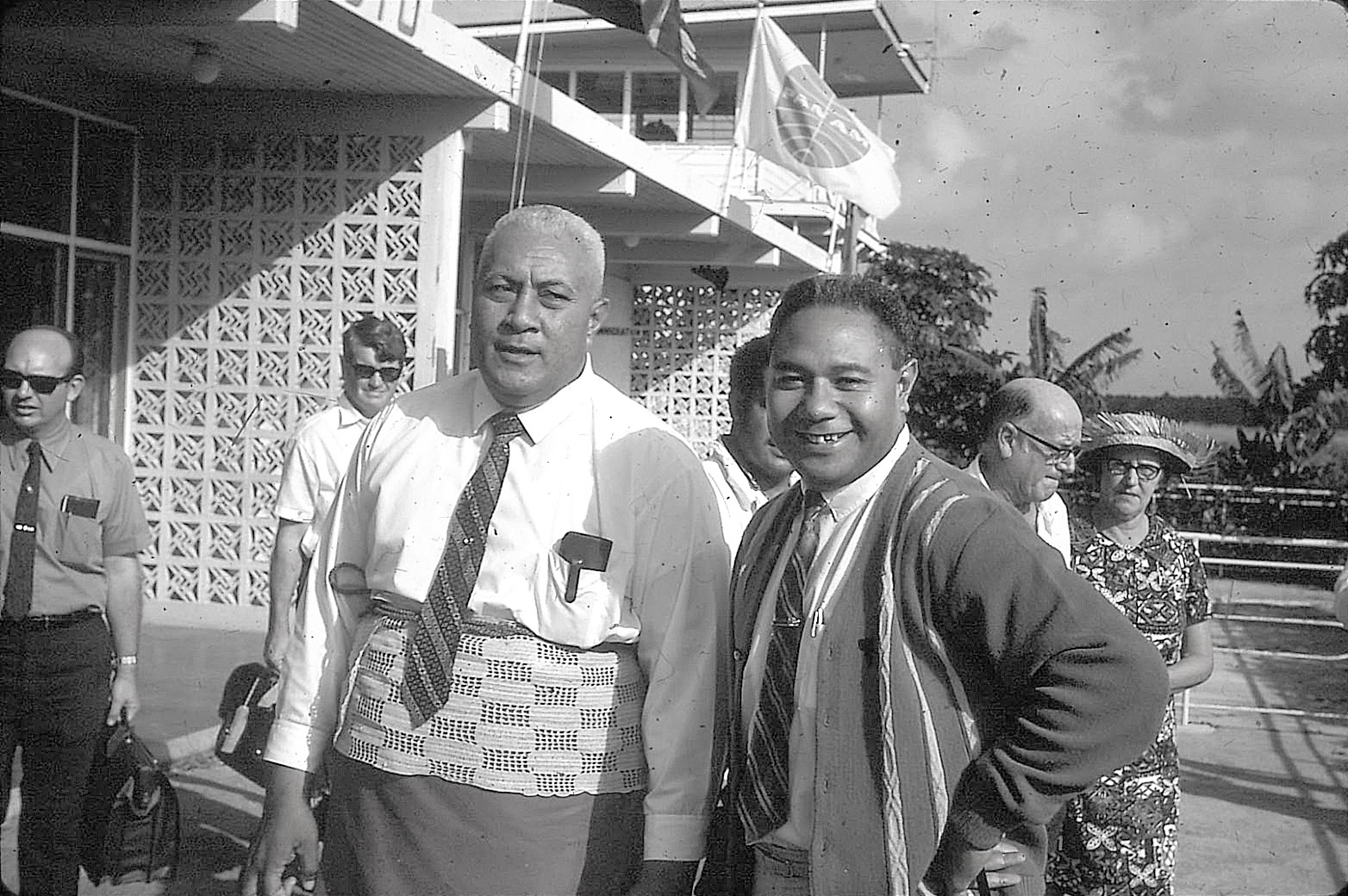 New stake presidents Folau Mahu‘inga and Tevita Ka‘ili. Bill Windsor collection, courtesy of Lorraine Morton Ashton.
New stake presidents Folau Mahu‘inga and Tevita Ka‘ili. Bill Windsor collection, courtesy of Lorraine Morton Ashton.
In 1971 Elder Howard W. Hunter, accompanied by Elder John H. Groberg, who was then the regional representative over the area, met in Fiji with President James Christensen of the Tongan Mission and President Wayne Shute of the Samoan Mission to discuss plans to create a separate mission in Fiji and to create another new stake in Tonga. The proposed new stake was approved in Salt Lake City and Elder Hunter returned in July to create the Nuku‘alofa East Stake with Vili Pele Folau as stake president. Now the entire island was covered by stakes. Many more were to follow.
Meanwhile, Tonga Toutai Paletu‘a, the Nuku‘alofa West Stake patriarch, was called as the new president of that stake, replacing Orson Hyde White, who was returning to America. President James Christensen, who had recommended that Brother Paletu‘a be called as the new stake president, recalled that Elder Hunter was very nervous that Brother Paletu‘a would feel bad about this change in calling. When they went to interview him at his home, Elder Hunter tentatively said, “I guess you are wondering why we’re here?” Brother Paletu‘a replied, “Oh no, I know.” Elder Hunter was taken aback. He said, “You know why I’m here?” Brother Paletu‘a’s response was, “Yes, we need a new stake president.” Paletu‘a pulled a paper out of his pocket. “I woke up in the middle of the night, the Lord already called me, and here is my speech. I wrote out my whole speech for it.”[1] President Christensen had previously told Elder Hunter that Brother Paletu‘a was “pure gold” and would respond to any call he was given. President Christensen went on to say that whenever he had a problem missionary, he would send that missionary to live with the Paletu‘as for a week and the missionary would come back full of the Spirit.
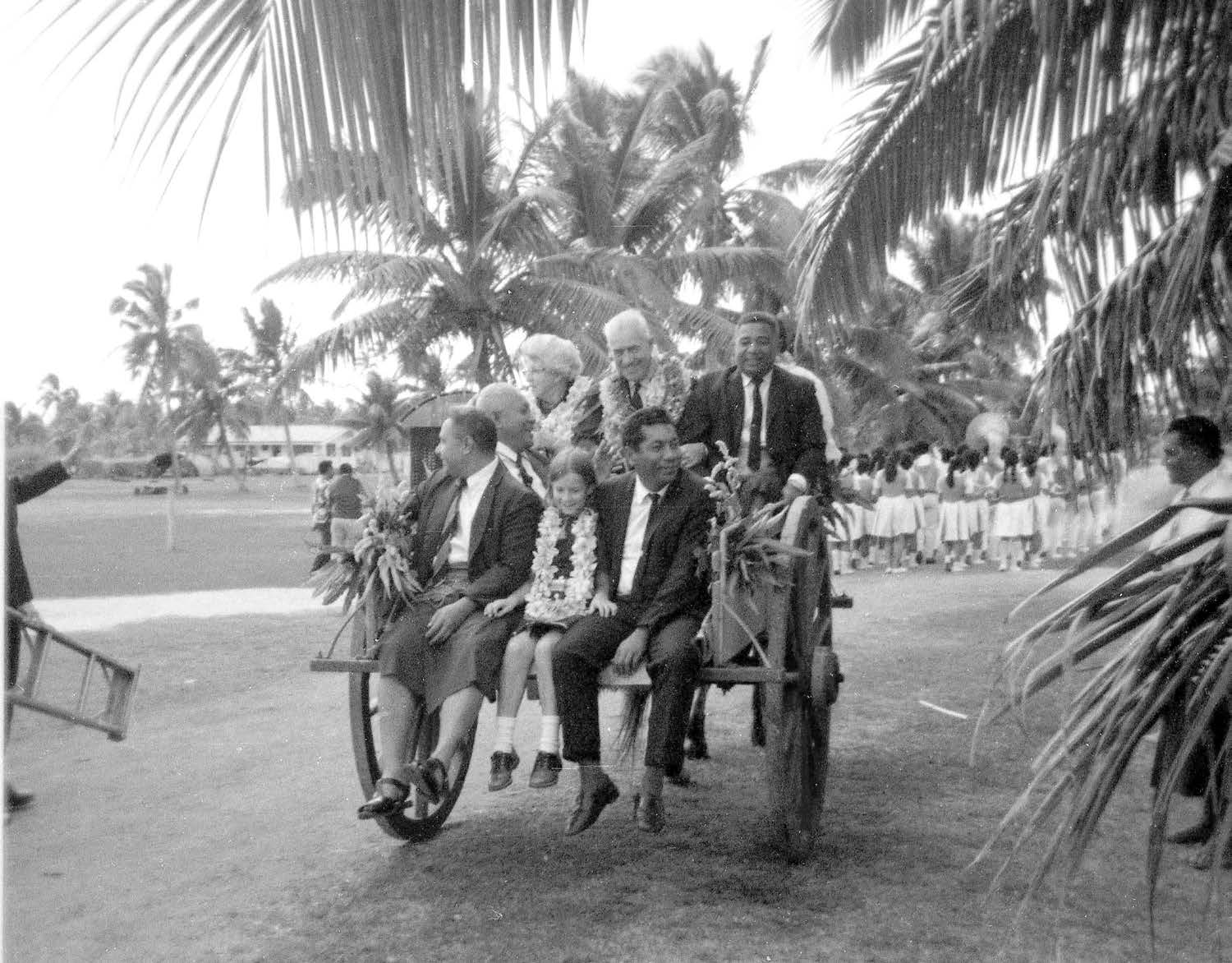 New stake presidents Folau Mahu‘inga and Tevita Ka‘ili. Bill Windsor collection, courtesy
New stake presidents Folau Mahu‘inga and Tevita Ka‘ili. Bill Windsor collection, courtesy
of Lorraine Morton Ashton.
Since stake conferences were regularly presided over by a General Authority, these new stakes in far-off Tonga required additional visits. Elder Mark E. and Sister Emma Petersen came with Elder Groberg to Tonga on September 1, 1971, and held conferences in all four stakes. After the Petersens returned to Salt Lake City, Elder Groberg stayed to hold regional meetings. This program of regular regional meetings brought more visits by leaders from Salt Lake City. The training sessions from the general presidencies of the auxiliaries that would come with Elder Groberg were always welcome and helpful and augmented the annual mission presidents’ seminars, usually held in Auckland.
This interaction with the leaders from Salt Lake strengthened the organization of the Church in Tonga. Elder Paul H. Dunn came to Tonga on March 4, 1972, to dedicate the new Nuku‘alofa South Stake Center at Havelu. Queen Mata‘aho attended as an invited guest. Two months later, when stake conferences were held in Tonga, Elder Franklin D. Richards was sent as the visiting General Authority and observed the devotion of the Saints. An editorial in the Church News described this devotion and discussed the faithfulness of the Tongan Saints. It mentioned that by law the Sabbath was sacred, and all businesses closed on Sundays so people could attend church. Many Latter-day Saint wards and branches reported 75–85 percent attendance. The Tongan Saints conducted family home evening regularly and were faithful tithe payers. They were modest in their dress and were law-abiding out of respect for their leaders. Their national motto, Koe ‘Otua mo Tonga ko Hoku Tofi‘a (“God and Tonga Are My Heritage”) was and is taken seriously.[2]
There was even a small new congregation of faithful members on the island of Niuafo‘ou. After a volcanic eruption in 1946, Queen Salote had evacuated all the people on Niuafo‘ou, often called Tin Can Island. However, before long some people began to return seasonally to gather coconuts to make copra. With no safe anchorage, the mail was sent out and delivered by swimming a large sealed biscuit tin to and from the ship. By 1972 about six hundred people had returned full time, and among them were thirty-three Latter-day Saints. They met faithfully in a little Tongan fale chapel in the village of Tongamama‘o.[3]
The Church’s progress in Tonga included increased membership along with social, economic, and cultural influence. As the Tongan Mission approached three thousand baptisms in 1970, King Taufa‘ahau IV was quoted in an article in the Fiji Times newspaper in August saying that “unless the Methodist Church acts quickly the official Methodist Kingdom will be Mormon by the year 2000.” Mission president James Christensen attributed this success to the quality of the six expatriate and 120 local missionaries, most of whom had been trained through regular religion classes at Liahona.[4]
Liahona Progresses
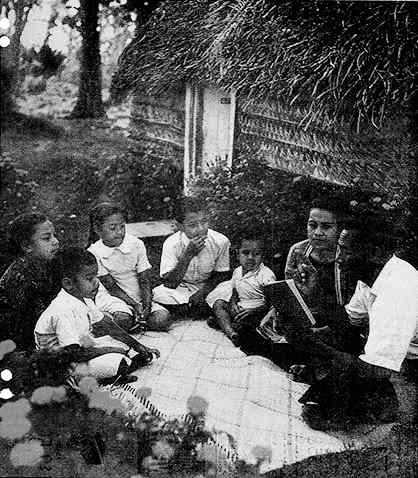 The Vilai Kupu family holding family home evening outside their home. From Church News, January 9, 1971.
The Vilai Kupu family holding family home evening outside their home. From Church News, January 9, 1971.
Liahona High School continued to serve an important role in preparing students to serve as missionaries. Under the direction of religion teachers Grant Williams and Tonga Toutai Paletu‘a, 127 seniors were assigned to serve as junior companions to missionaries on Tongatapu for a week during August 1970. After everyone reported back, these student missionaries were credited with assisting in the conversion of 209 new members of the Church.[5]
Across from Liahona High School, a Church construction compound with workshops, warehouses, and homes for the supervisors was created to support the continuing building program of chapels. Tongan graduates from the Church College of Hawaii continued to return to teach at Liahona. Several returning Tongan teachers brought non-Tongan wives, whom they had met and married in Hawai‘i, who also taught. Many of these women—such as Helen Lātū, Ana Moleni, and Marie Paongo—used their native English-speaking background to help the students at Liahona improve their English skills.
Liahona was self-sustaining in that it produced all the food it needed and even had some surplus to sell. Brother Jerry Spier managed the Church-owned plantations, with 327 acres at Niumate, 200 acres at Liahona, 123 acres at Meleka, and 75 acres at Makeke. Much of the land was double cropped with food crops and livestock under rows of coconuts, providing fourteen tons of root crops, vegetables, milk, and eggs each week for the cafeteria.[6]
George Puckett arrived January 20, 1972, to replace Orson White as superintendent of Church Schools in Tonga. White’s replacement was immediately well liked and proved to be a very effective administrator within the Church schools. As the 1972 school year started in February, 915 secondary students were enrolled at Liahona and 853 middle school students enrolled throughout the kingdom.[7] On February 22 another delegation arrived from Utah to meet with school leaders in Tonga. The next day Elder and Sister A. Theodore Tuttle, Brigham Young University president Dallin Oaks, Tongan Mission president James Christensen, and the newly appointed Superintendent Puckett were able to have an audience with King Taufa‘ahau Tupou IV at his palace to discuss the objectives of the Church’s educational program with His Majesty.
Activities of President Christensen
President Christensen and one of his counselors, Manase Nau, continued working to strengthen relationships with the royal family and other hou‘eiki. President Christensen joined the Rotary Club and became close to the crown prince, Tupouto‘a. The prince told him, “We know in order to hold our power over the people we need to be part of their religion. If the royal family were to join the Mormon Church, they would lose that political power over the people.”[8] President Christensen felt that members of the royal family had a very positive opinion of the gospel—maybe even a testimony of it. The Christensens were invited to all the royal receptions and open houses. In President Christensen’s opinion, this was partly because his wife, Metta, would speak Tongan with the other Tongan wives, which helped them feel more comfortable in social settings that generally involved non-Tongans.[9] Manase Nau was even able to invite the royal family to dinner at the new mission home in Sopu, something that would have been considered an impossibility in prior years, and it turned out to be a delightful event. He also gave Queen Mata‘aho a set of Book of Mormon tapes and a tape player. She said she “listened to every one of them.”[10]
During this time period, a significant change was made to the mission. On May 7, 1971, President Christensen had met with Elder Gordon B. Hinckley at Nadi, Fiji, to investigate the possibility of making Fiji a separate mission. With five expatriate missionaries and eight local missionaries, Fiji had baptized 188 converts in 1968 and 227 in 1969. Elder Hinckley also wanted to determine if there were any Indo-Fijians among Fiji’s membership that were available to go to India as missionaries.
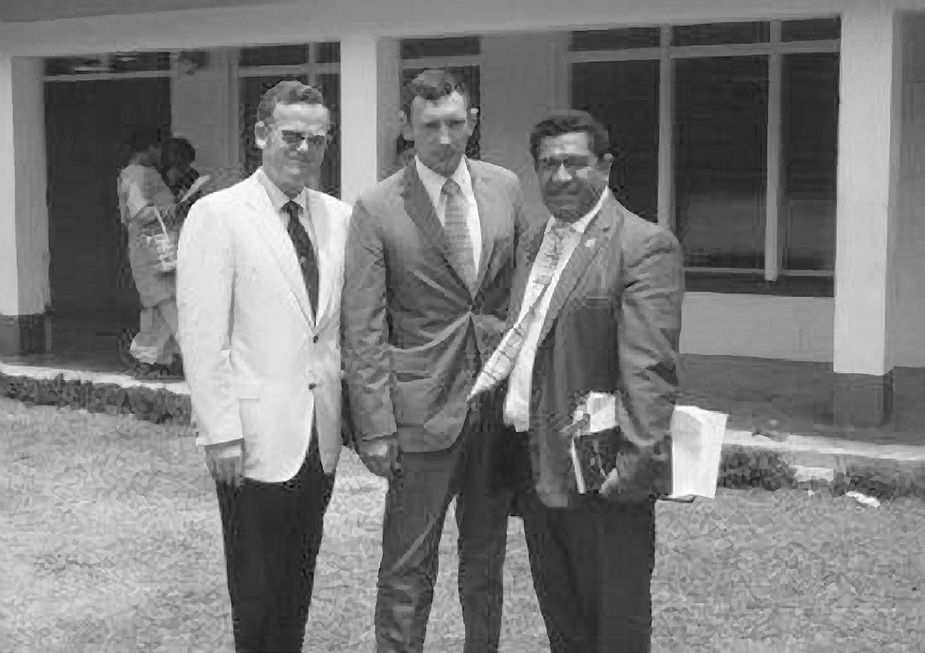 President Charles (Chuck) Woodworth (center) with his counselors George Puckett (left) and Hamani Wolfgramm (right). Courtesy of Jerry Dobson.
President Charles (Chuck) Woodworth (center) with his counselors George Puckett (left) and Hamani Wolfgramm (right). Courtesy of Jerry Dobson.
The separate mission was approved, and on July 23, Elder Hunter came with Elder Groberg and announced the creation of the new Fiji Mission at a meeting in the Suva chapel and called Sherman Lindholm, a senior missionary already serving as the district president in Fiji, to be the mission president. This new mission included Niue—which had long been a part of the Tongan Mission but at that time was part of the Samoan Mission—and the Cook Islands, which were part of the New Zealand North Mission. President Lindholm’s mission was completed after just one year. Ebbie Davis, a teacher at Liahona, was called on June 24, 1972, as the next president of the Fiji Mission.
In the Tongan Mission, which had over two hundred missionaries, President Christensen decided that instead of proselytizing all day, the missionaries could spend the afternoons fellowshipping, performing service, and playing sports with the youth. They could quickly visit every home in their small villages, so getting to know the people on a more personal level increased conversations. President Christensen felt that an occasional faikava helped to break down barriers and allowed for gospel conversations that the missionaries otherwise may not have had. Half the missionary force consisted of sisters, a unique situation in the Church. They were often more productive than the elders.
President Christensen also fostered relationships as he found ways to help the Tongans with their temporal needs. For some time, the Saints in Tonga paid tithing in kind. Usually this consisted of foodstuffs, which were given to the Liahona cafeteria for students, but the Relief Society sisters would sometimes donate their handicrafts such as woven mats, baskets, and tapa cloth. These were usually stored in the mission president’s garage at the mission home in Sopu. In March President Christensen bought them all using his own money and donated them to a new children’s hospital in Auckland through his Nuku‘alofa Rotary Club connections. President Christensen also presented $25,000 to the Tongan government on behalf of the Church for the Vaiola Hospital.
Christensen completed his term as president of the Tongan Mission, and on July 3, 1972, the Christensens went to the king’s palace to bid him farewell and to thank him for granting the land at Sopu for the new mission home. President Christensen was replaced by Charles (Chuck) Woodworth, who had served his mission on Niue from 1955 to 1958 and then returned with his wife, Marsha, to teach at Liahona for a short time in 1959. President Woodworth chose Hamani Wolfgramm and George Puckett from Liahona as his counselors. At the end of the 1972 school year, the first Tongan principal of Liahona was called: James William (Bill) Harris. Brother Harris was originally from Neiafu but was educated in New Zealand, where his family had moved, and at the Church College of Hawaii, where he was the valedictorian of his class. He had been supervising the middle schools since 1965.[11]
President Woodworth Localizes Leadership
President Woodworth had some novel ideas on mission administration. Beginning at a meeting on July 1, 1973, he proposed placing the responsibility for supervising missionary work under the stake presidents. At a mission presidents’ seminar in Sydney in September, he presented his plan to Elder Gordon B. Hinckley, who approved it. In a meeting on Tongatapu at Havelu on November 28, 1973, President Woodworth officially placed the missionary program under the direction of the stake presidents and stake mission presidents. From that time, all native missionaries were to be transferred back to their own stakes or districts, and each stake or district would call full-time missionaries from their own localities to meet their missionary needs. President Woodworth believed that Tonga was unique in that the stakes and districts could provide all their own missionaries. On Tongatapu, at least, the stakes could take care of all the administrative and spiritual matters relating to the missionary program. The mission leaders would function in a training and advisory role. President Woodworth felt that the mission was truly following the priesthood correlation program, in which the stake presidencies were to teach bishops their missionary responsibilities and members were to carry out their finding and fellowshipping responsibilities.
Throughout the year, several General Authorities and General Officers of the Church visited Tonga to conduct stake conferences. They provided a great deal of valuable training. Elder S. Dilworth Young came on February 8, Elder Marvin J. Ashton came on May 22, and Elder John H. Vandenberg came on November 3. The regional meetings continued regularly under the direction of Elder Groberg, the regional representative. When Groberg came on March 10, 1973, he brought with him Russell M. Nelson, the Sunday School General President. That year, stake presidencies and bishops had the opportunity to attend general conference in Salt Lake City, which provided a wonderful experience and training opportunity.
In late November Elder Groberg visited to obtain a firsthand report on the transference of the missionary responsibilities to the stakes. He held a regional meeting in early December with all the stake presidencies and stake mission presidencies to get their input. He was pleased with what he saw happening in Tonga but did notice some deviations from traditional procedures.[12] Elder Groberg also appointed Dr. Peni Mapa as regional welfare services leader to supervise the medical and health missionaries and all other welfare-related concerns.
In his effort to focus on missionary work, Woodworth sent all the real estate and financial records to the Church construction office at Fualu, directly across the street from Liahona. Unfortunately, the Latter-day Saint construction employees did not know what to do with these records. Consequently, several leases went into arrears, and the Church lost the lease on the Latai chapel in Nuku‘alofa and almost lost the lease on Liahona.[13]
In his year-end report for 1973, President Woodworth mentioned that while baptisms were low, he had confidence that as the missionaries and members understood the new program and moved forward with it, baptisms would pick up. He also was looking forward to turning the Church schools over to Tongan leaders and having the last of the overseas personnel replaced with locals. His goal was to have Tonga totally self-sufficient in terms of leadership. In his year-end report he declared, “We have attained the Church ideal in having local missionaries meet local needs under local leadership.”[14] By 1974 most of the Liahona teachers contracted at a U.S. salary were gone, and the few new palangi faculty members such as Riley Moffat, Brent Anderson, and Howard Lua were hired at the Tongan pay scale.
Tonga Toutai Paletu‘a Called as First Tongan Mission President
Elder John Groberg came to hold regional meetings starting March 13, 1974. He said, “The time has arrived for local leaders to prepare themselves to carry the full program of the Church.”[15] He said this would be the last time that auxiliary leaders would come from Salt Lake City for regional meetings unless specifically invited; thus Tonga would run its own auxiliaries. This total localization of leadership took effect on May 7, 1974, when Elder Groberg announced that Tonga Toutai Paletu‘a, who had been called by President Kimball, would replace President Woodworth immediately as mission president as part of the leadership localization initiative.[16] The Woodworths left on May 16. Elder Thomas S. Monson arrived a few days later to help Elder Groberg set President Paletu‘a apart and provide training in his new assignment. Under President Paletu‘a the supervision of missionary work was returned to the mission president. The next day, Elders Monson and Groberg and President Paletu‘a met with the king for nearly an hour. The king was obviously pleased to see a Tongan leading the mission.
A memorable and faith-promoting event took place shortly after President Paletu‘a was called as mission president. Moleni Tanginoa Fonua related the experience:
Just after Toutai Paletu‘a was appointed mission president in 1974, he came to Ha‘apai to preside over a conference of the Church. I was district president at the time. After the conference my counselor, Folaumoehau, and I took the president with all his luggage to the inter-island ferry, the Olovaha. I heard the conversation between the crewman and his captain: “The president of what church?” asked the captain. “The president of the Mormon church,” answered the crewman. “Order those two men to swim for it then. This vessel is not returning to shore.” I felt desperate and begged the crewman to ask the captain a second time to wait and signal a launch from shore to come and get us. We got the same answer.
The Olovaha had already pulled out into deep water. We either jumped overboard or sailed with the Olovaha, not to return for a whole week. The real problem was that poor Folaumoehau could hardly swim a lick. Yet we could not leave our duties in Ha‘apai. So we jumped overboard to make our way as best we could. Once in the water I immediately reached for Folau to help him. To my surprise, Folau said that he was just fine, that he was standing on a rock and didn’t need help.
Her Royal Highness Princess Salote Mafile‘o Pilolevu and James William (Bill) Harris at the
Liahona High School Culture Day. Courtesy of Riley Moffat.Now we were many yards from shore in water dark and deep. I know that area very well. He did not struggle at all. There were no rock or coral head there. But Folau felt he was standing on a rock. Miraculously he had no trouble keeping his head above water even though he was not swimming. Soon a little outboard came and took us rejoicing back to shore.
During the days following, we felt very grateful for the Lord’s mercy especially in behalf of Folau. In this spirit of gratitude, when the Olovaha called again at Pangai, Folau and I decided to do a favor for the captain of the Olovaha. We prepared for him a formal presentation of food with all the trimmings, a presentation worthy of a high dignitary.
When we presented ourselves with the food, we thanked the captain for commanding us to leave his boat by jumping overboard. Otherwise we would not have had this miraculous experience which has increased our understanding of Heavenly Father’s love and power.[17]
Undoubtedly the prayers of President Paletu‘a helped greatly with this miraculous event as he remained on the Olovaha and traveled to Vava‘u.
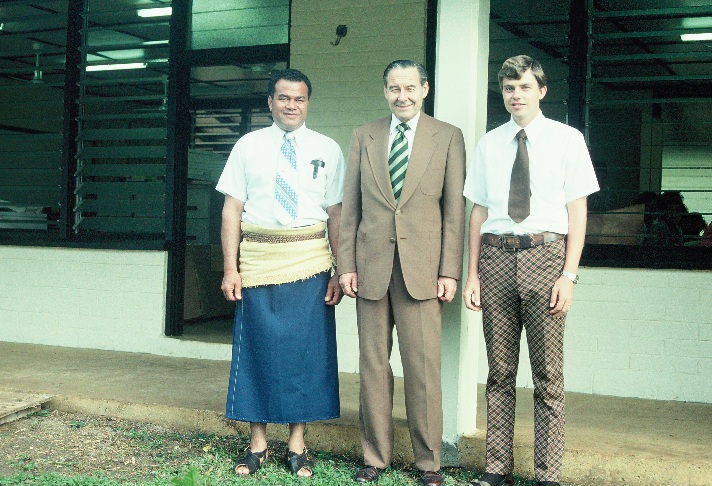 Left to right: President Mosese Langi, Elder Robert L. Simpson, and Elder Brent R. Anderson. Courtesy of Brent R. Anderson.
Left to right: President Mosese Langi, Elder Robert L. Simpson, and Elder Brent R. Anderson. Courtesy of Brent R. Anderson.
Other changes occurred and adjustments were made to facilitate missionary work and strengthen and support members of the Church in Tonga. On April 28, 1975, President Paletu‘a received word that Niue would be transferred from the Fiji Mission back to the Tongan Mission. It had been part of the Fiji Mission since its creation in 1971. He made two trips there in June and July and reported much inactivity. The members were not keeping Church standards, and missionary work was “lackadaisical.”[18] President Paletu‘a quickly corrected this situation. At that time there were three hundred missionaries in the Tongan Mission, obviously more than they needed. The desire to serve was great, especially from those young people who had been trained through the seminary program at Liahona.
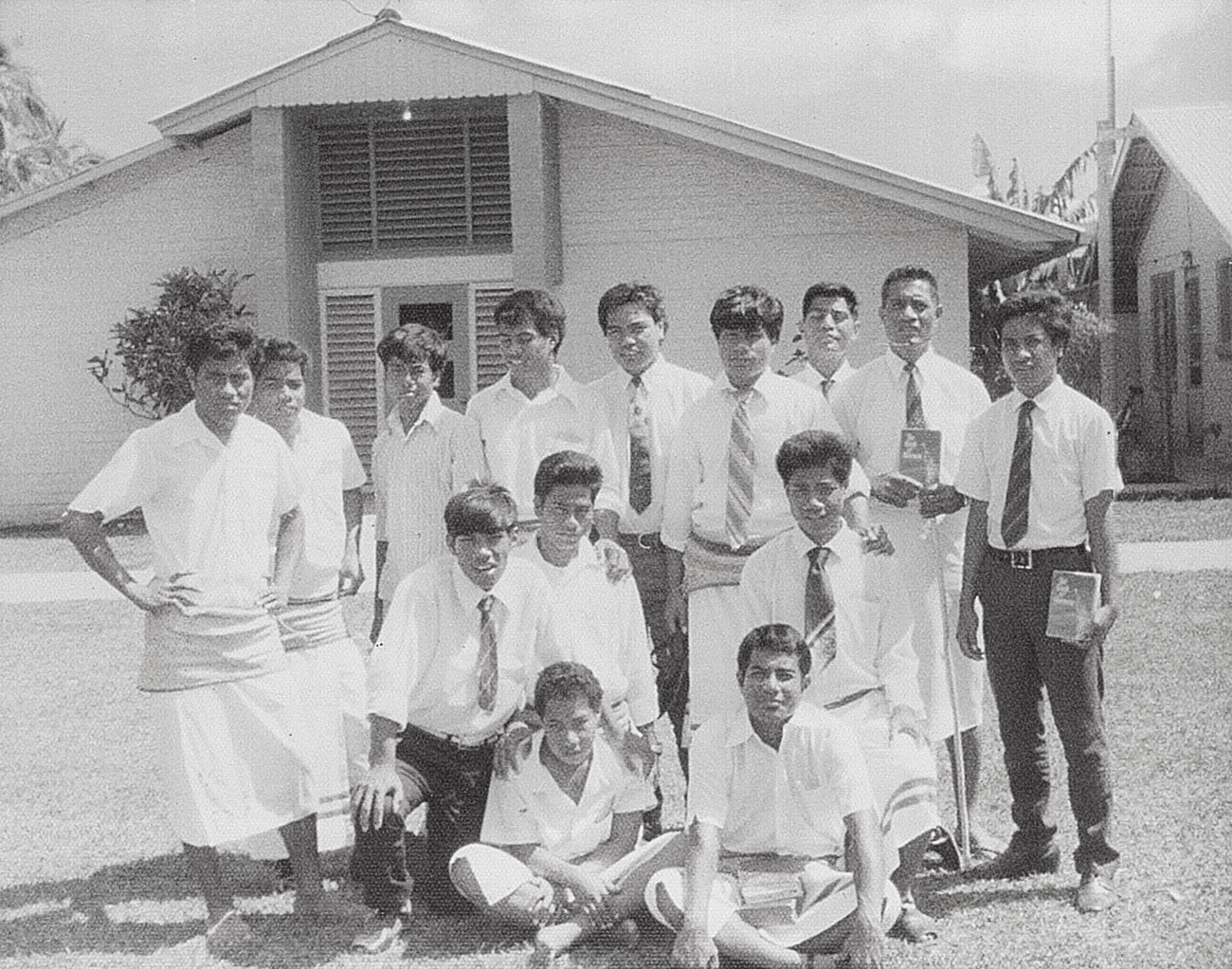 Gilbertese Island boys at Liahona, 1974. Courtesy of Riley Moffat.
Gilbertese Island boys at Liahona, 1974. Courtesy of Riley Moffat.
Elder Gordon B. Hinckley arrived on December 2, 1975, to create the first stake on Vava‘u, and Mosese Langi was called as the first stake president. The following day, the airplane crashed that was supposed to transport Elders Hinckley and Groberg and President Paletu‘a from Vava‘u back to Tongatapu. Consequently, they had to charter the Hifofua for five hundred dollars to get back to Nuku‘alofa. That was all the money they had with them. Back on Tongatapu, they reorganized the East Stake, calling Pita Hopoate as stake president. The next day, Elders Hinckley and Groberg visited the king.
The localization efforts initiated by Elder Groberg resulted in changes at Liahona High School as well. As the school returned to a more traditional Tongan government curriculum under local leadership, test scores for the Higher Leaving Exam continued to improve, eventually competing with the best of the other secondary schools. In late 1974 Liahona presented their first candidates for the “School Certificate” exam, which would give them national recognition.
Liahona High School continued to host many foreign students because it had facilities for boarding students. However, by 1974 the last of the students from Tahiti had graduated, and no new Tahitians had arrived. There remained between twenty or thirty students from Fiji, both native Fijians and Indo-Fijians, along with six to eight Cook Islanders.
Gilbert Islanders at Liahona
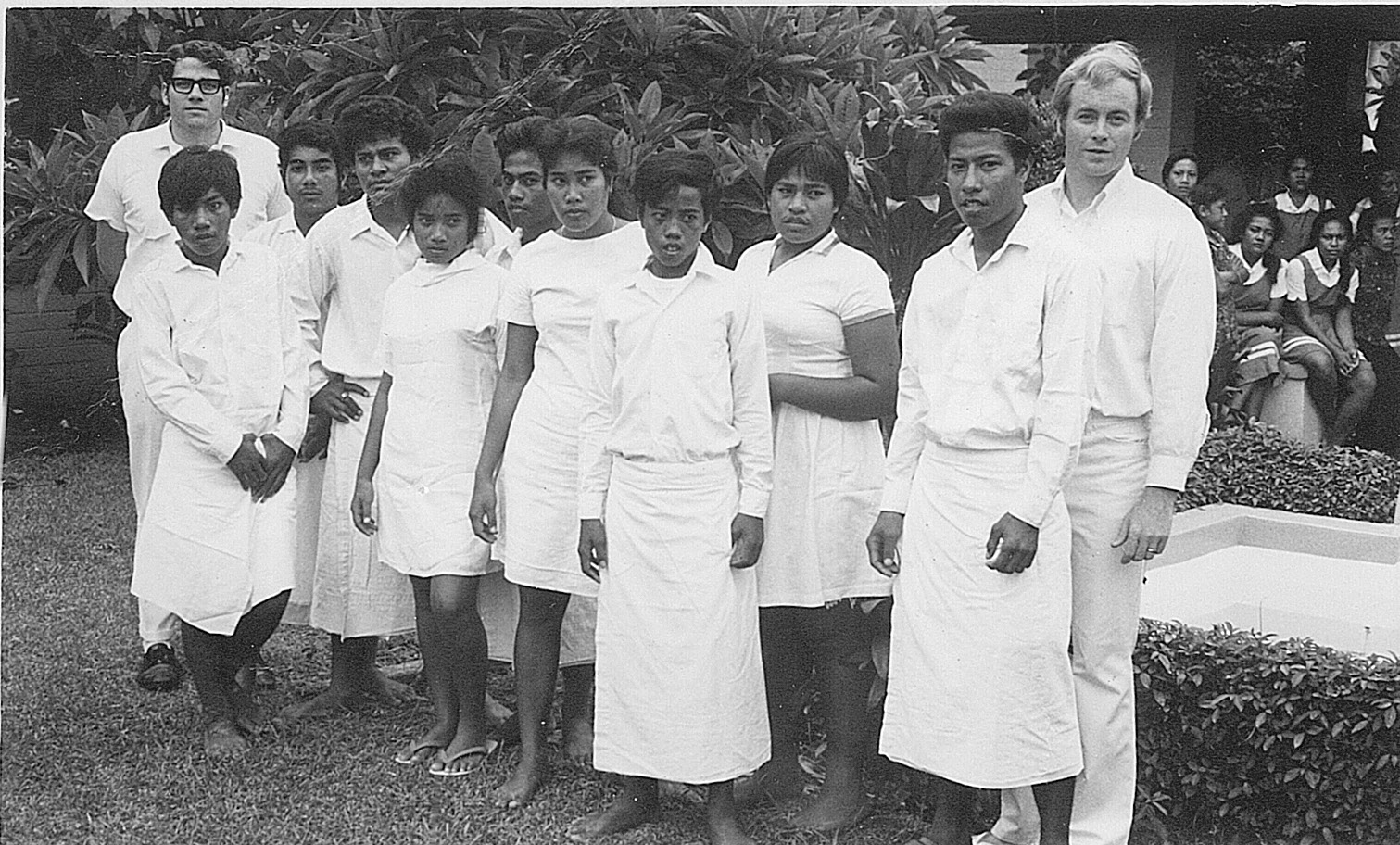 First group of Gilbertese Islanders getting baptized. Courtesy of Jerry Dobson or Courtesy of Riley Moffat.
First group of Gilbertese Islanders getting baptized. Courtesy of Jerry Dobson or Courtesy of Riley Moffat.
However, in 1972, Liahona played host to what was a true miracle when a small private school in the Gilbert Islands, now called Kiribati, pleaded with the Church to allow some of its students to study at Liahona. At that time, there were no known members in the Gilbert Islands. Church Educational System administrator Alton Wade, Tongan Church Schools superintendent George Puckett, and others visited the little school on Tarawa and selected thirteen students to come to Liahona in 1973. Within a year, they all had been baptized, and in each of the following years about a dozen more Gilbertese students arrived. These Gilbertese students who had been baptized wanted to return and introduce the gospel to their islands. On March 26, 1975, six Gilbertese young men who had graduated from Liahona were called on missions. They spent several months serving as companions to missionaries on Tongatapu; then in October they went to Fiji for more training before going on to theTarawa atoll in the Gilbert Islands. Gilbertese law prohibited foreign missionaries from proselytizing until there were at least fifty local members, so these elders were on their own and endured tremendous persecution.
Finally, Grant and Pat Howlett, teachers at Liahona who were close to the Gilbertese students, arrived on Tarawa on August 2, 1976, as teachers to take over administration of the little school there and watch over the missionaries. The next year another couple from Liahona, Siaosi and Ana Moleni, were called to assist them. On November 27, 1976, six more Gilbertese elders were called from Tonga to serve in the Gilbert Islands. Before long, with the help of these Liahona teachers, the Church started the Moroni High School in Kiribati. This was the beginning of the Church in that nation,[19] and it had all started at Liahona.
Saineha High School
In 1974 Bill Harris replaced George Puckett as superintendent of Church Schools in Tonga and was the first Tongan in that position. Harris was a native of Vava‘u and seized the opportunity as “his dues to his homeland.”[20] One of his first projects was to propose a new secondary school in Vava‘u. Looking at the number of Vava‘u students in the dorms at Liahona, Harris felt there were enough young people in Vava‘u to warrant a separate school. He presented his report to the Church Board of Education in Salt Lake City, and it was approved by President Kimball. From February 14–16, 1975, Neal A. Maxwell, Church Commissioner of Education, and Alton Wade, who supervised Church schools in the South Pacific, visited Vava‘u to assess the situation. A beautiful property was acquired in Neiafu, and construction began immediately. Under the supervision of district president Mosese Langi, an experienced labor missionary, thirty young men were called as labor missionaries.
Construction moved quickly on the new secondary school at Neiafu. It was ready for classes at the beginning of 1976 under the leadership of Principal Hamani Wolfgramm even though construction was not complete.[21] Now it needed a name. The Saints of Vava‘u were invited to submit their suggestions. The Hebrew name Saineha, submitted by Pita Pauni of Ha‘alaufuli, won. It came from a scriptural passage in Abraham 3:13 and meant “the sun.”[22]
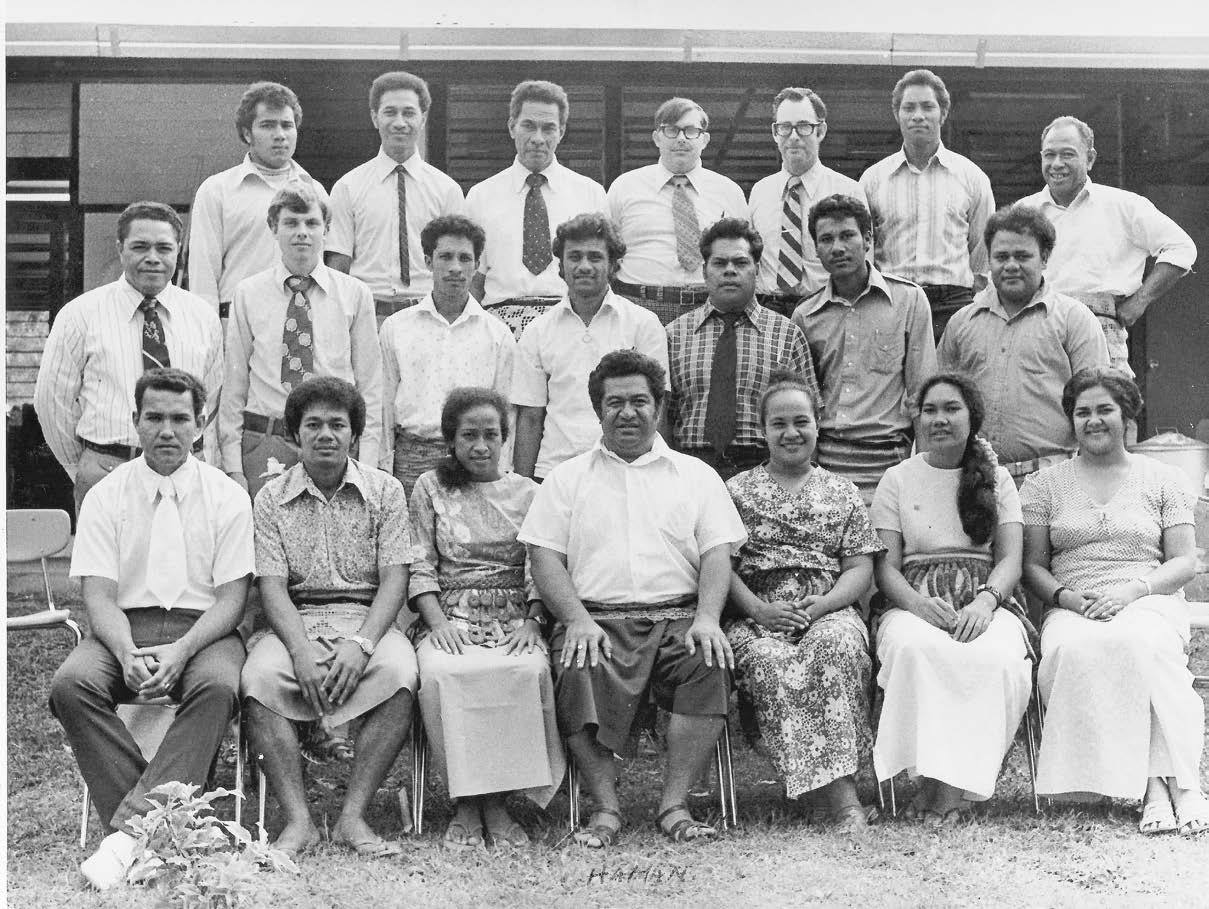 First faculty of Saineha High School. Bottom, left to right: 'Utolofi Sanft, Tevita Lavulavo, Ehuti Mo'unga, Hamani Wolfgramm, Saineha Tupola, Seini Vea, Emelia Tu'inukuafe; middle, left to right: Tavake Vehikite, Brent Anderson, Faka'osilea Kaufusi, Taufa Topou, Ika Fifita, Sifiveni Naeata, Nuku Tupola; top, left to right: Tevita Moli, Samisoni 'Uasila'a, Tevita Kata Tu'akalau, John Reeves, Robert Wall, Paula Tu'itupou, Vaea Tangitau. Courtesy of Hamani Wolfgramm.
First faculty of Saineha High School. Bottom, left to right: 'Utolofi Sanft, Tevita Lavulavo, Ehuti Mo'unga, Hamani Wolfgramm, Saineha Tupola, Seini Vea, Emelia Tu'inukuafe; middle, left to right: Tavake Vehikite, Brent Anderson, Faka'osilea Kaufusi, Taufa Topou, Ika Fifita, Sifiveni Naeata, Nuku Tupola; top, left to right: Tevita Moli, Samisoni 'Uasila'a, Tevita Kata Tu'akalau, John Reeves, Robert Wall, Paula Tu'itupou, Vaea Tangitau. Courtesy of Hamani Wolfgramm.
Two years later, Elder Groberg was assigned to dedicate the campus, but getting to Vava‘u on the scheduled day was a problem. The plane was late, and it became dark before they reached Vava‘u. There were no lights at the airport in Vava‘u, and the pilot wanted to turn back. However, Elder Groberg was inspired to promise him that there would be hundreds of members there with flashlights and car and truck headlights to line the runway and that they would be able to land safely. At the same time, Samisoni ‘Uasila‘ā and the Saineha band, along with a group who had come to perform a lakalaka dance for Elder Groberg, had waited all day at the airport. They used their vehicle headlights to light the grass airstrip for the 8:00 p.m. arrival.[23] Ten minutes later, as the pilot made his initial pass over the runway, he saw many lights coming on along each side of the runway. Elder Groberg knew that the Lord and the faithful Saints of Vava‘u waited for him and had prayed him safely there. He arrived at Saineha eight hours late, but no one had left, and no one had touched the feast that had been prepared for 2:00 p.m. There were several Tongan protocols that needed to be carried out, and it was midnight before Elder Groberg thought it appropriate to begin the actual dedication proceedings. All was accomplished properly according to Tongan timing and protocol, and no one seemed overly concerned about the time so long as it was done right.[24]
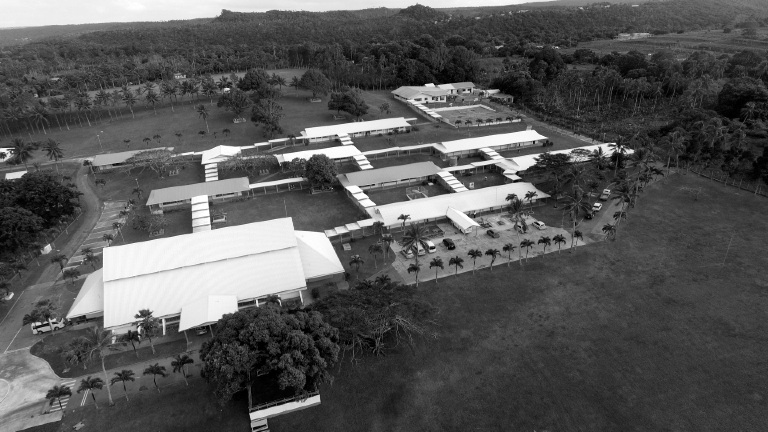 Aerial view of Saineha High School. Courtesy of Martin Anderson.
Aerial view of Saineha High School. Courtesy of Martin Anderson.
The construction of Saineha eliminated the need for Vava‘u students to live in the dorms at Liahona, so that left openings for other students to receive an education at Liahona. The middle school students on Vava‘u could also attend school at Saineha as day students. In 1976 the Fiji LDS Technical College opened, and students from Fiji who had been coming to Liahona for almost twenty years were also able to attend their own new secondary school in Suva, which freed up more dorm space. In the 1980s the Kiribati students that had been attending Liahona were able to stay and go to the new Moroni High School in Eita, Tawara, Kiribati.
First Tonga Area Conference
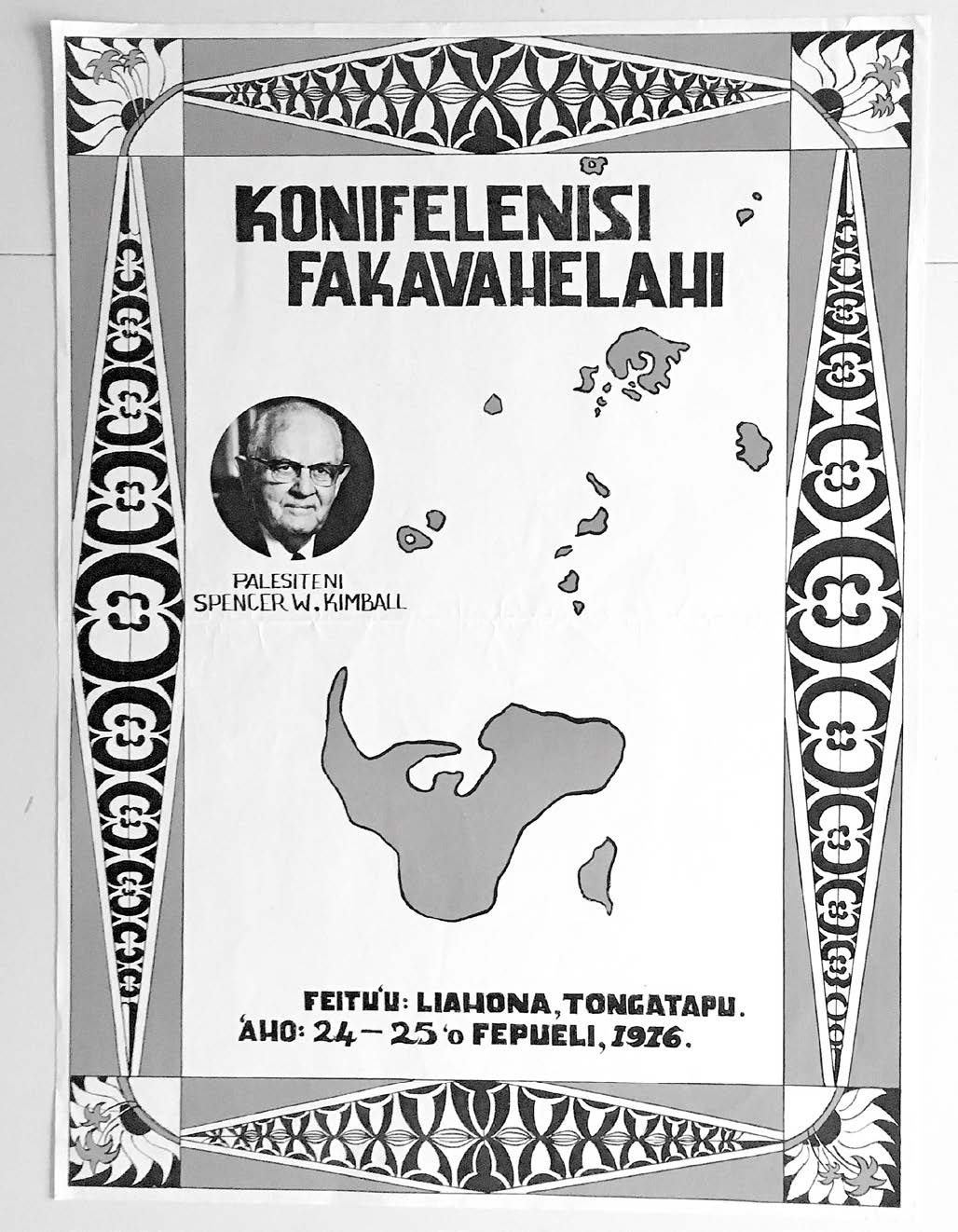 Poster for Area Conference. Courtesy of Riley Moffat.
Poster for Area Conference. Courtesy of Riley Moffat.
A monumental event in the history of the Church in Tonga occurred in February 1976 when one of the first Church area conferences was held at Liahona High School. All members in Tonga were invited to attend and receive counsel from several General Authorities. Planning went on for months. The vessels Aoniu and Hifofua were rented to bring the Vava‘u and Ha‘apai Saints to the conference. Everyone wanted to come, and the heavily overloaded boats arrived in Nuku‘alofa on February 21. At a missionary conference, Elder Kelikupa Kivalu reported on the work on Niue. Elders Malohifo‘ou and Mokofisi, the first missionaries to proselytize in the New Hebrides, now called Vanuatu, reported on their thirteen-month mission to that country. A number of General Authorities arrived for the conference: President and Sister Spencer W. Kimball, President and Sister N. Eldon Tanner, Elder and Sister David B. Haight, Elder and Sister Robert L. Simpson, Elder and Sister Robert D. Hales, President Russell M. Nelson, Brother and Sister David M. Kennedy, Bishop Victor L. Brown, Elder Marion D. Hanks, Elder Bruce R. McConkie, and Elder Loren C. Dunn. President Kimball was interviewed by the government radio station A3Z and the Tonga Chronicle newspaper. Eight thousand six hundred Saints attended the conference.[25]
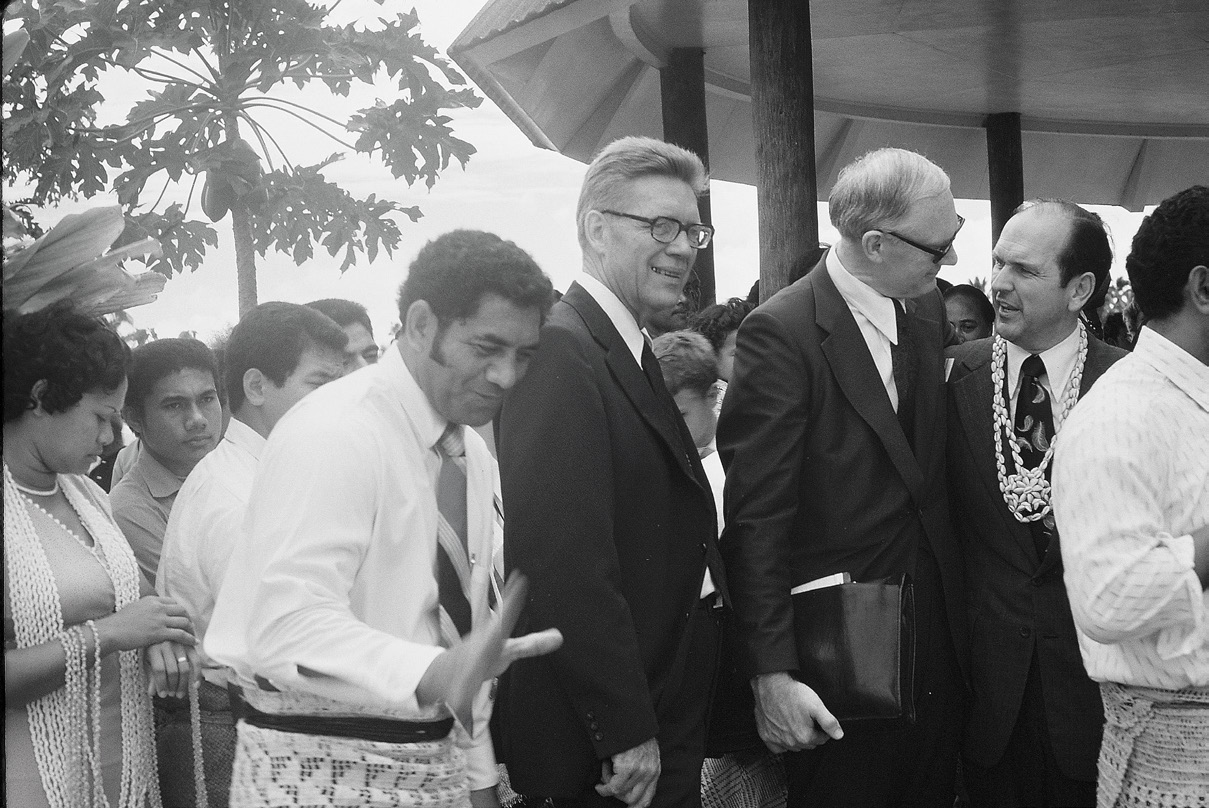 Saia Paongo, Elders Bruce R. McConkie and Loren C. Dunn, with President Russell M. Nelson at the Area Conference. Courtesy of Jerry Dobson.
Saia Paongo, Elders Bruce R. McConkie and Loren C. Dunn, with President Russell M. Nelson at the Area Conference. Courtesy of Jerry Dobson.
In the conference, President Kimball thanked the Tongan people for providing all their own missionaries and said that someday a temple would probably be built in Tonga. He indicated that Zion was there in Tonga and directed members to stay and make Tonga a Garden of Eden. “We need people to stay where they are and build Zion,” President Kimball counseled.[26] It was fine to go overseas to get an education, but it was important to return and raise a family in Tonga. Other talks, such as Elder Simpson’s, also centered around the theme of the Tongan Saints staying in Tonga and building up the Church there. Many powerful sermons were given, but unfortunately some Saints disregarded the counsel of the Brethren and left for Utah—emigration actually increased after the conference.[27]
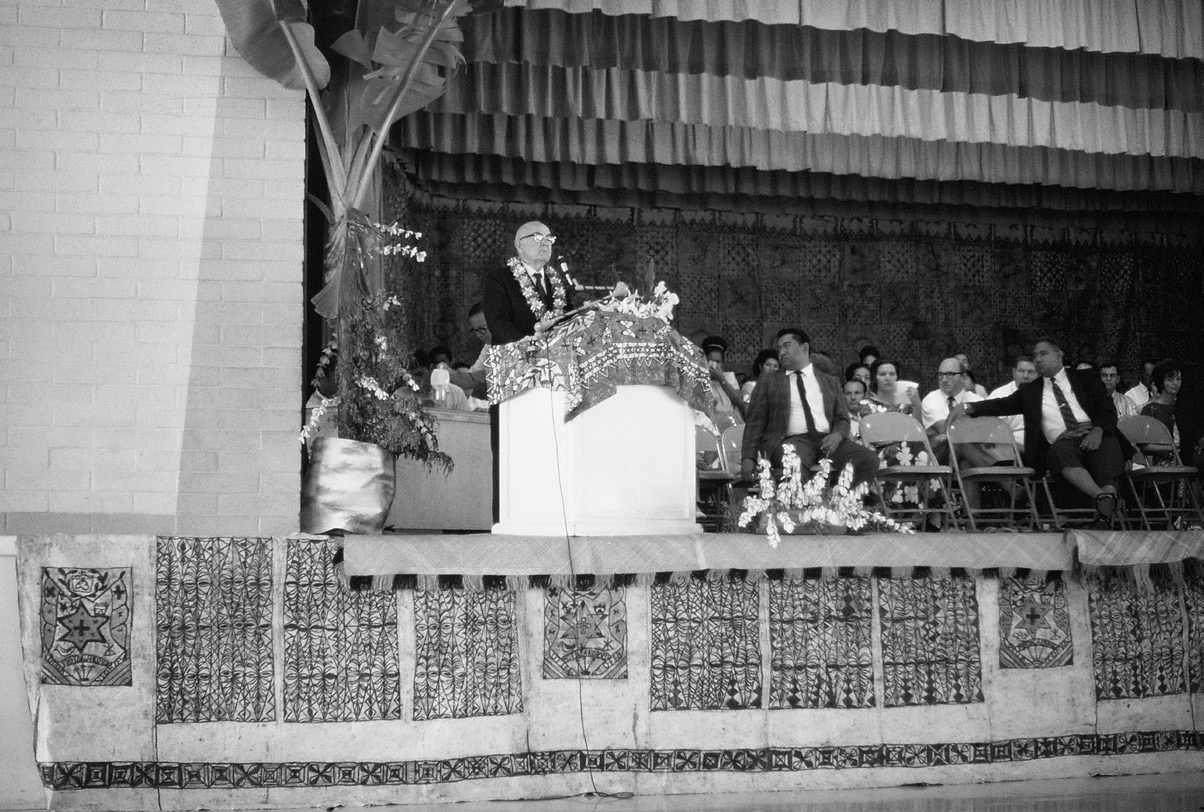 President Spencer W. Kimball speaking at Area Conference. Courtesy of Jerry Dobson.
President Spencer W. Kimball speaking at Area Conference. Courtesy of Jerry Dobson.
Pita Hopoate, then stake president in Mu‘a, recalled that President Kimball prophesied that Tonga would be the first country in the world to produce more missionaries than it needed and would then be able to send them around the world. This prophecy soon came true. The wonderful singing during the conference inspired Sunday School General President Russell M. Nelson to change the general “singing practice” then held during Sunday School opening exercises to “worship through music.” President Nelson later wrote, “The Tongans sang song after song as their means of expressing gratitude to God and to his prophet for the spiritual experience they had enjoyed. In my remarks I indicated that the singing of the Tongan saints, which I was privileged to observe in a regional meeting assignment three years previously, had led to a change in the format of the Sunday School program for the whole world.”[28]
Soon after this great conference, all Tonga felt honored when President Kimball called John Groberg, their Kolipoki, to be a member of the First Quorum of the Seventy.[29] He was released as a regional representative and called to preside over the Pacific. His replacement as regional representative was Tufunga Samuela Atoa, who was responsible for the regions of both Tonga and his native Samoa.
At the end of 1976 the mission history reported there were 171 elders, 127 sisters, 50 stake missionaries, seven health missionaries, and six agricultural missionaries, for a total of 361 missionaries serving in Tonga. Since there were only 90,000 people in the entire country, over 15,000 of whom were already members, this resulted in a very favorable situation for missionary work. The mission had 925 convert baptisms that year. No other country in the world claimed these kinds of numbers—especially in comparison to the population size.
The relationship between the Church and the royal family was strengthened on October 20, 1976, when King Taufa‘ahau Tupou IV received an honorary doctorate degree at BYU–Hawaii presented by the university’s president, Dan W. Andersen, who was accompanied by BYU president Dallin H. Oaks, Elder Gordon B. Hinckley, and Hawai‘i governor George Ariyoshi. The king praised the Church’s efforts to educate the youth of Tonga and hoped they would return with their education to bless the Kingdom of Tonga.[30]
President Sione Tu‘alau Lātū
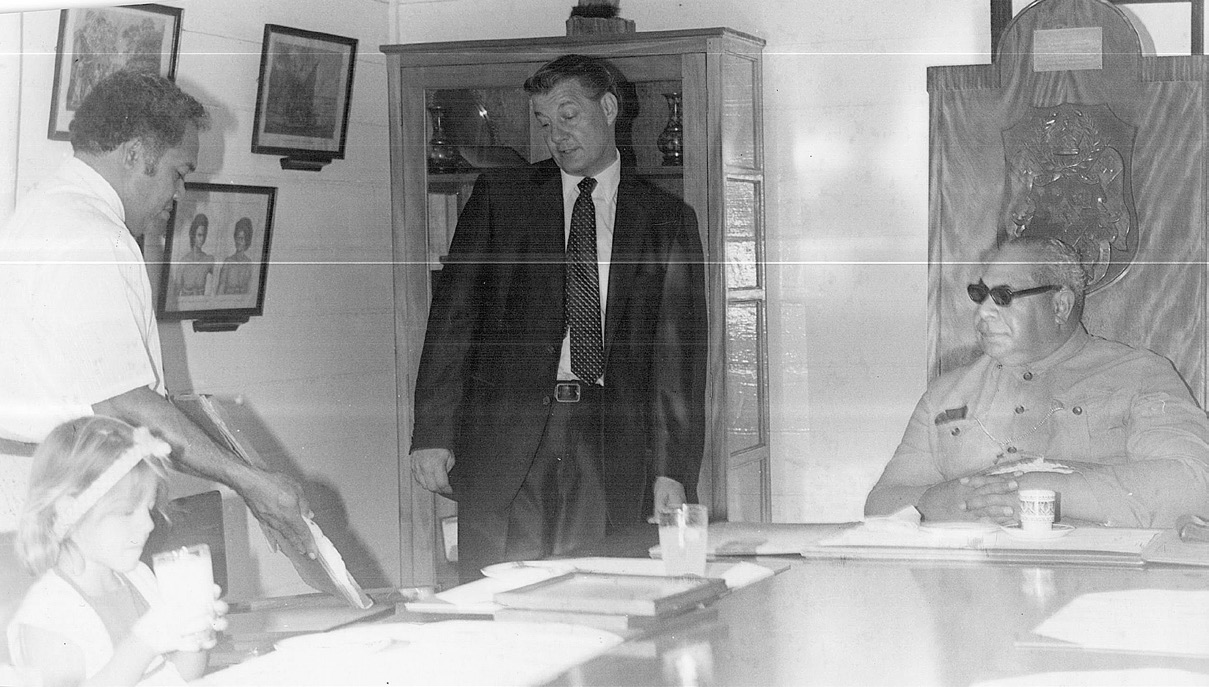 President Sione Tu‘alau Latu, Elder John Groberg, and King Taufa‘ahau Tupou IV. Courtesy of Kakalosi Kioa Tu‘ione.
President Sione Tu‘alau Latu, Elder John Groberg, and King Taufa‘ahau Tupou IV. Courtesy of Kakalosi Kioa Tu‘ione.
In 1977 Sione Tu‘alau Lātū replaced Tonga Toutai Paletu‘a as mission president. President Lātū was a product of Liahona High School and the Church College of Hawaii. He was an outstanding example of going overseas to get an education, then returning to serve in Tonga. President Paletu‘a was called on July 1, 1977, to replace Tufunga Samuela Atoa as the first native Tongan regional representative. On January 11, 1978, President Lātū called Taniela Kelikupa Kivalu and Mosese Fehoko Naeata as his counselors. President Kimball’s prophecy of Tonga exporting missionaries began to be fulfilled on January 28; six Tongan elders were called to serve in the Micronesia Guam Mission, and six prospective elders began learning Spanish from Sister Charlene McMurray at Saineha High School in Vava‘u in preparation to serve missions in Bolivia. It was obvious at this point that Tonga could produce more missionaries than it needed. Later that year twelve elders left for the Philippines, two went to Kiribati, six went to Fiji, and the six who had completed their Spanish training left for Bolivia. Outside of the United States, there was nowhere else in the world where this was happening. The young people who were called to serve overseas became one of Tonga’s most valuable exports. They could thrive in environments difficult for many North American missionaries, and they enjoyed a reputation for being hard workers. In Tonga the number of convert baptisms for 1978 was an astounding 2,449, or 2.5 percent of the total population.
Building on the foundation of the 1950s and 1960s, the Church was moving ahead in Tonga both spiritually and temporally. Opportunities to learn from apostles and prophets strengthened leadership and testimonies. The Church enjoyed mature leadership, and there were more well-prepared missionaries than they could use. New chapels were being built and the only thing Tonga lacked for total spiritual self-sufficiency in the kingdom was a temple.
Notes
[1] James Christensen, interview by Brent Anderson and Riley Moffat, June 15, 2018, Draper, UT.
[2] “Lessons from Tonga,” Church News, October 30, 1971.
[3] William H. Dame, “The Thirty-Three Saints of Tin Can Island,” Ensign, June 1972, 22–27.
[4] “Tongans Respond to Home Evening Program,” Church News, January 9, 1971.
[5] “Junior Missionaries Get 209 Baptisms,” Church News, September 12, 1970.
[6] “Down on the Farm,” Church News, May 2, 1970.
[7] “Church Education around the World,” Church News, February 19, 1972.
[8] Christensen, interview.
[9] Metta Christensen had become quite fluent in Tongan while studying with Ermel Morton during her service as a missionary teacher at Liahona in the 1950s.
[10] Christensen, interview.
[11] “Key Positions Filled at Pacific Church Schools,” Church News, November 25, 1972.
[12] MHHR, by date.
[13] Christensen, interview.
[14] MHHR, by date.
[15] MHHR, by date.
[16] MHHR, by date.
[17] Moleni Tanginoa Fonua, interview by Eric B. Shumway, December 21, 1988. See also Moleni Tanginoa Fonua, “Returning Good for Evil,” in Tongan Saints: Legacy of Faith, ed. Eric B. Shumway (Laie: Institute for Polynesian Studies, 1991), 270–71.
[18] MHHR, by date.
[19] Grant Howlett, “From Beginnings to an Open Door in the Gilbert Islands, 1976–1978,” CHL. See W. James Jacob, “A Beacon to the Isles of the Sea: How Education Brought Gospel Light to Kiribati,” in Pioneers in the Pacific, ed. Grant Underwood (Provo, UT: Religious Studies Center, Brigham Young University, 2005), 277–91. See also “12 Tonga Students Open Way,” Church News, May 8, 1976, 13.
[20] Folau Kioa, “A Brief History of Saineha High School in CES Tonga, 1976–1990” (master’s thesis, Brigham Young University, 1997), 4.
[21] “Tongan Always Taught to Be Faithful Member,” Church News, June 5, 1976.
[22] Kioa, “Brief History of Saineha High School,” 6. In Abraham 3:13 the name appears Shinehah.
[23] Samisoni ‘Uasila‘a, interview by Brian Sokolowsky, 2003, CHL.
[24] John Groberg, The Fire of Faith (Salt Lake City: Bookcraft, 1996), 296–300. See also Kioa, “Brief History of Saineha High School,” 6–7.
[25] “Conferences Continue in South Seas,” Church News, February 28, 1976, 5.
[26] “The Prophet’s Visit,” Church News, March 6, 1976.
[27] See the area conference report in the Ensign, May 1976, 138–39.
[28] Spencer J. Condie, Russell M. Nelson: Father, Surgeon, Apostle (Salt Lake City: Deseret Book, 2008), 175.
[29] “Early Commitment Set Life’s Pattern,” Church News, May 1, 1976, 5.
[30] “Church Honors Tongan King,” Church News, October 30, 1976.
